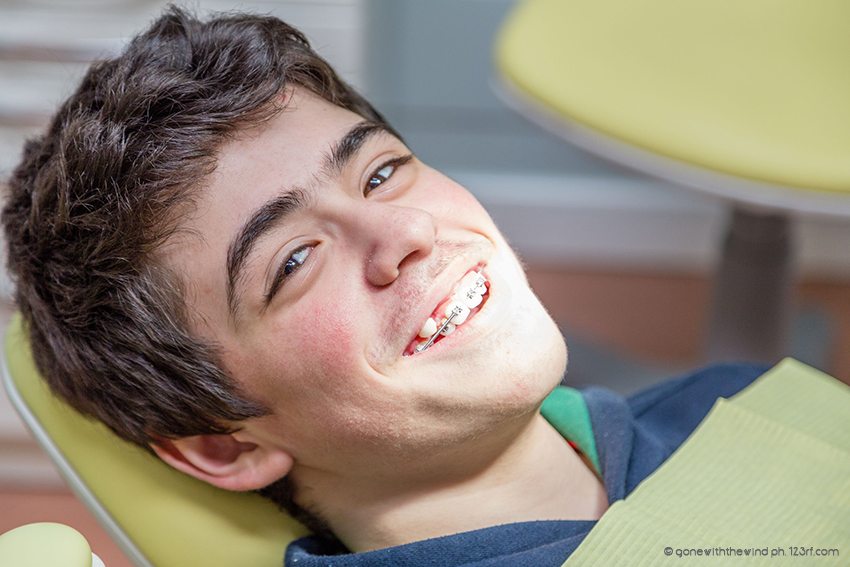
Mio figlio ha bisogno dell’apparecchio!
Molte mamme si sono trovate in questa situazione. Hanno dovuto capire come orientarsi tra le varie opzioni prospettate, spesso senza sapere esattamente che cosa si racchiude dietro la comune parola “apparecchio per i denti”.
Ecco una brevissima sintesi che ci può aiutare nel primo approccio a questi dispositivi. Ce lo spiega la dott.ssa Leonella Caliari, Odontoiatra specialista in Ortodonzia presso il Centro Ortodontico Vicentino.
Nella parola apparecchio per i denti confluiscono una miriade di tipologie di dispositivi. Ne troviamo di fissi, mobili, invisibili o trasparenti, che si distinguono certamente per modalità di inserimento in bocca ma anche per tipologia di impiego che viene stabilita a monte da un vero e proprio studio del caso ortodontico.
L’apparecchio infatti è solo un dispositivo che, applicando delle forze, provoca lo spostamento dei denti. Per farlo in modo corretto però è fondamentale la diagnosi effettuata dall’Ortodontista, ovvero lo specialista delle malocclusioni e della crescita delle ossa facciali. Mediante lastre del cranio, radiografie, modelli in gesso delle arcate dentali, stato di crescita delle ossa della faccia, abitudini e maturità del bambino, valuta quale sarà il percorso idoneo e più efficace per controllare i denti e definire un corretto sviluppo dei mascellari e dunque del viso.
Ciò che ancora molti non sanno è che l’apparecchio per i denti non ha limiti di età. Può infatti essere molto utile anche alle persone mature che, grazie alle versioni trasparenti o interne alle arcate dentali (linguali), non riscontrano problematiche estetiche tipiche delle versioni fisse classiche esterne. Previa attenta valutazione ortodontica, non ha nemmeno controindicazioni nei bambini molto piccoli (3 anni di età). In questo caso è fondamentale per correggere malocclusioni, come il morso crociato, che potrebbero compromettere la crescita equilibrata della mandibola.
Quali sono le principali tipologie di apparecchio
Le due principali macrocategorie in cui si distinguono gli apparecchi – cosa che interessa principalmente i genitori – sono la versione fissa e mobile. Ovvero quella incollata ai denti piuttosto che quella rimovibile dal paziente per mangiare o in altri momenti della giornata.
Tra gli apparecchi fissi troviamo il modello con attacchi, o piastrine, incollati ai singoli denti e su cui passa un filo metallico che è il vero motore del sistema perché riesce o spostare i denti. Molto utilizzato è anche l’espansore rapido, o “ragnetto”. L’espansore viene posizionato sul palato per espandere un’arcata molto stretta e far spazio per l’arrivo dei denti permanenti, oppure per correggere un’inversione della masticazione. Altre volte è possibile impiegare apparecchiature rimovibili (come la trazione extraorale o baffo) su strutture fisse in bocca per esempio di notte.
Gli apparecchi rimovibili sono di varie forme e possono avere molteplici applicazioni. Spesso sono utilizzati per controllare la spinta della lingua, per aiutare la mandibola a crescere in posizione corretta oppure per rimuovere abitudini alterate.
Oltre a queste abbiamo le versioni trasparenti che impiegano una serie di mascherine (allineatori) che progressivamente correggono l’allineamento dentale. Non costituiscono un trattamento utile per tutti. E’ infatti l’ortodontista, dopo un’attenta analisi delle radiografie e della posizione dentale, che stabilisce se il trattamento con gli allineatori è realizzabile; generalmente si propone per ragazzi più maturi e responsabili o per gli adulti.
E i vantaggi di un trattamento piuttosto che l’altro?
Ovviamente la prescrizione di una specifica tipologia di apparecchio per i denti dipende dal tipo di lavoro ortodontico che dobbiamo eseguire. L’apparecchio fisso è efficace nella maggior parte dei casi perché permette un maggior controllo dello spostamento dentale. Richiede però una manutenzione igienica scrupolosa: ai pasti principali bisogna lavarsi i denti e le manovre di pulizia sono un po’ più lunghe rispetto agli apparecchi rimovibili. Dico sempre ai genitori che l’apparecchio di per sé non genera carie ma, se i batteri, non vengono rimossi efficacemente, troveremo con facilità demineralizzazioni dentali.
Il vantaggio dell’apparecchio rimovibile è dato dalla maggior facilità di esecuzione delle manovre igieniche e dell’alimentazione che avviene senza dispositivo. In questo caso è necessaria la massima collaborazione del piccolo paziente che dovrà dimostrare una buona maturità nel mettere e togliere il dispositivo secondo prescrizione.
Nel caso degli apparecchi invisibili, invece, il vantaggio maggiore consiste nella possibilità di vedere i risultati ottenibili sul proprio sorriso ancora prima di intraprendere il trattamento. Uno speciale scanner, infatti, trasformerà le impronte delle arcate dentali del paziente in modelli virtuali visibili a computer.
Si potrà dunque conoscere in modo preciso la durata del trattamento e visualizzare tutti gli spostamenti dentali pianificati dall’ortodontista per il proprio caso. Ovviamente gli allineatori dovranno essere tolti solo per mangiare o in poche altre circostanze perché il risultato ottimale di ottiene indossandoli per almeno 20 ore al giorno.
Il costo
E poi c’è la variabile costo. Strettamente connessa al tipo di correzione da effettuare, essa è la risultante di un insieme di voci, spesso non considerate nella valutazione del prezzo che si sofferma solamente sul dispositivo ortodontico. La parte più importante dell’intera terapia – che ne determinerà il successo finale – è costituita dal lavoro diagnostico e di programmazione del progetto ortodontico operata dallo specialista in molte ore di studio a cui si aggiungono le molte visite di controllo durante e dopo il trattamento.
Per ogni problema esiste lo specialista adatto: per correggere un difetto visivo c’è l’oculista, per un problema osseo l’ortopedico, così come per un problema ortodontico esiste l’ortodontista.
Il mio consiglio dunque è di affidarvi sempre a uno specialista in ortodonzia – e non a un dentista generico – qualora dobbiate intraprendere un percorso che influirà in modo determinante su una buona masticazione, sulla pronuncia delle parole e sul corretto sviluppo del viso di vostro figlio. Non dimentichiamo che una cura ben impostata dall’inizio, alla fine risulterà più breve e meno costosa.